“It took something completely extraordinary to tempt me to a new challenge right now, but the opportunity to become head coach of FCK will probably only come about once in my career.” This is what Jess Thorup said when he was announced as the new head coach at FC København in November 2020. Thorup was tasked with replacing Ståle Solbakken, who left to become head coach of the Norwegian national team after being in charge in Copenhagen since 2013.
The Dane was brought to the club from Belgian side KRC Genk, this after also managing KAA Gent in Belgium, whom he led to second place behind Club Brugge before the 2019/20 season was cancelled due to the COVID-19 pandemic. He has also won a Danish Superliga title with FC Midtjylland in the 2017/18 campaign. This season he is on track to guide FCK to their first league title since the 2018/19 campaign; with the club sitting six points ahead of Midtjylland going into the Championship playoff rounds. This tactical analysis piece will look at a few of the tactics that Thorup has implemented into the side this season, as well as hope to get a better understanding of his philosophy.
Formations
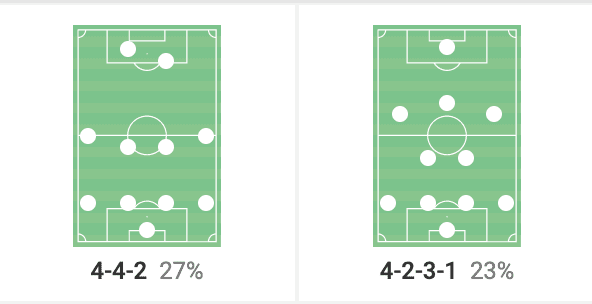
When it comes to the formations that Thorup has utilised this season with København, they have been relatively steady. He has mostly used both the 4-4-2 and 4-2-3-1, with the latter being the more common formation throughout the second half of the season. However, Thorup is tactically flexible, with the formation sometimes altering many times throughout a match with it not surprising to see København in either a 4-1-4-1 or even a 4-5-1 at points in a match.
Build-up play
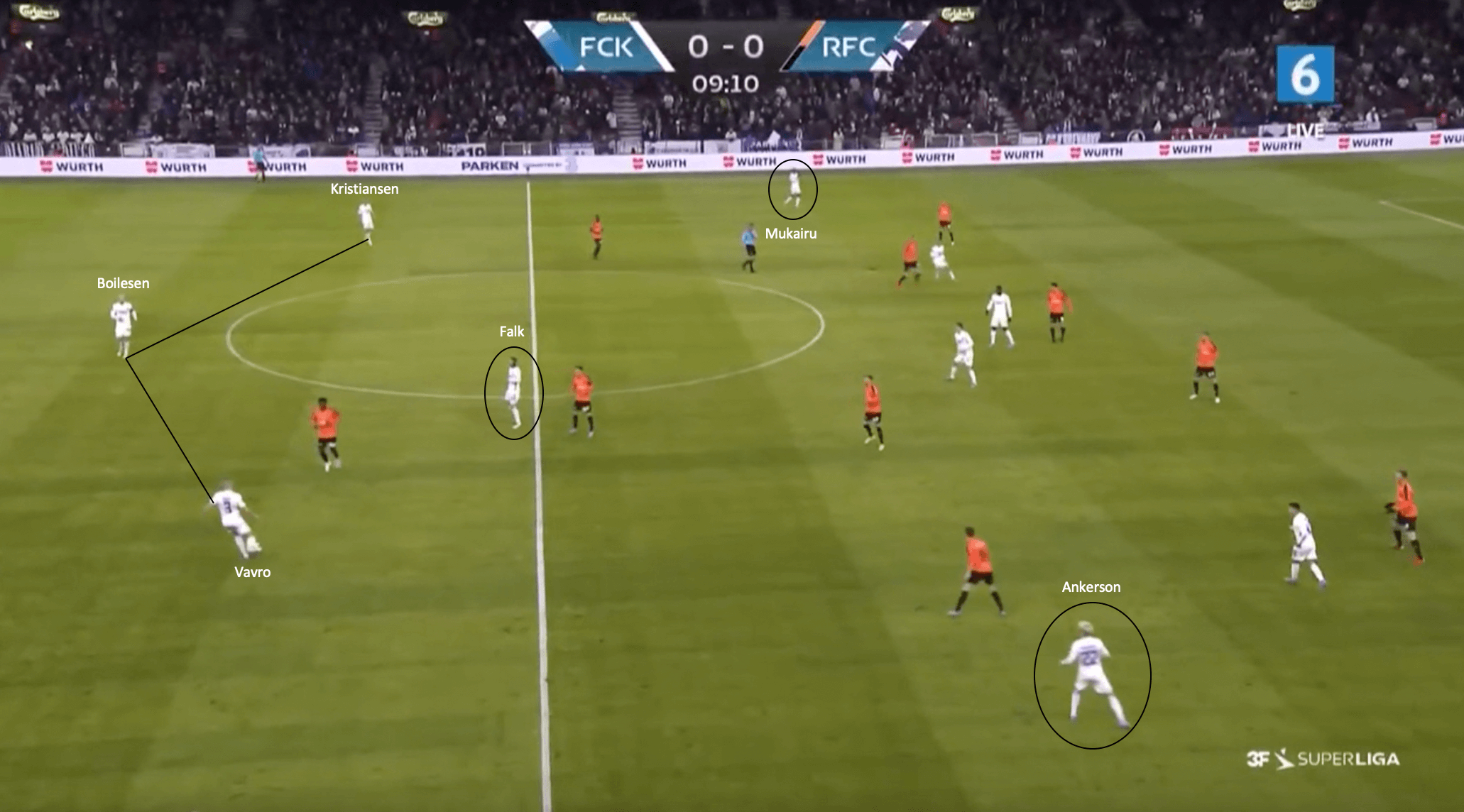
When it comes to build-up sequences, the image above shows the typical way that FC København build-up play under Jess Thorup. They tend to form a back three, with one of the fullbacks dropping in, while the other keeps the width in a more advanced position. In this phase against Randers, Ankersen is the fullback tasked with keeping the width. On the far touchline, Paul Mukairu drifts wide to keep the width there. The other attackers crowd the central areas, interchanging positions and making decoy runs to drag the opposition defenders inside to keep them narrow. This results in space out wide, which is often where København looks to initiate goal scoring chances.
In the image above, that is exactly how the play develops. Vavro plays the pass centrally to Boilesen, who is able to drive forward with the ball into the vacant space in midfield. Both Babacar and Biel make decoy runs, which drags the defenders inside and allows the pass to be played to Mukairu out wide. He is then able to drive into the Rander’s penalty box, and win a corner for København as a result.
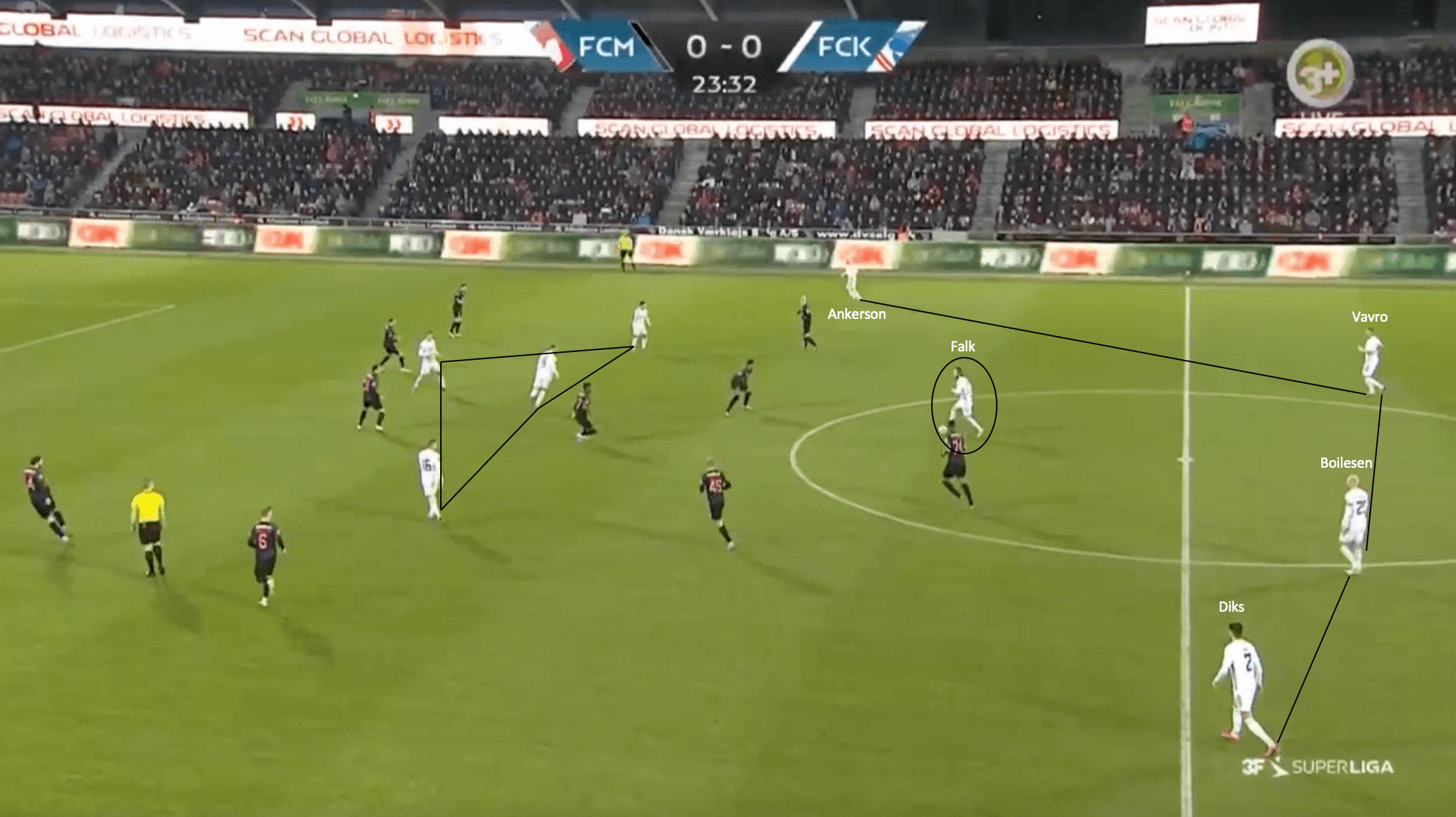
The image above shows another example of this build-up play utilised by FC København, this time against FC Midtjylland. As before, Ankerson is the fullback tasked with pushing high and keeping the width on the far touchline, while Diks drops into the backline to become the third defender. Falk drops into a deeper midfield position, while the rest of the attackers overload the central zones, dragging the Midtjylland defenders into more central positions. This allows Falk to play the pass to Mukairu, who is positioned wide on the near touchline. Because of the Midtjylland players being dragged centrally, he is afforded the space to drive towards the penalty box, with Diks bursting forward to make an overlapping run. Unfortunately, the attacking phase does not result in any chance being created, but it does show the opportunities that form from this style of build-up play.
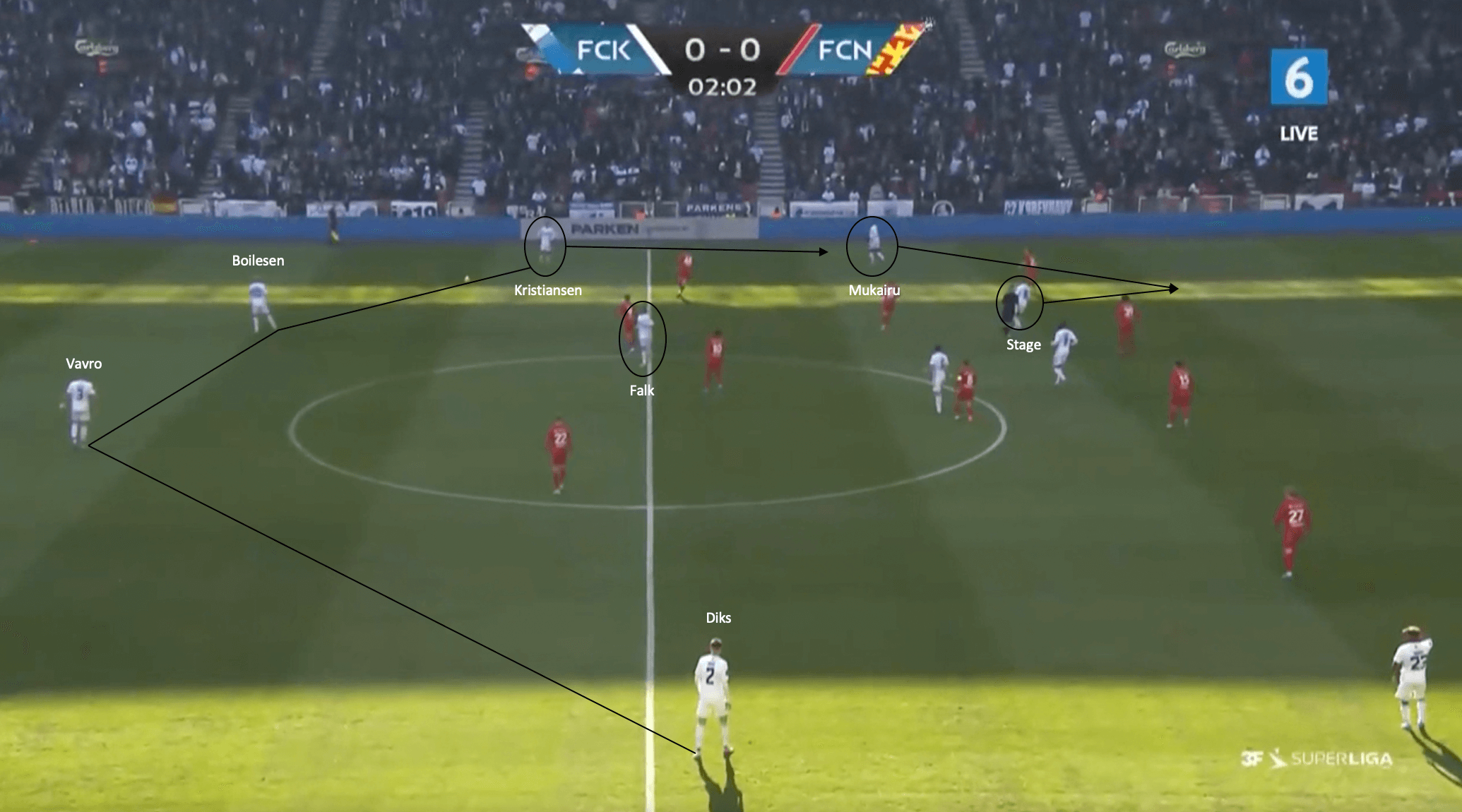
The image above shows another example of København’s build-up play, and this time, an example of the quick incisive passing that Thorup looks to achieve with it. Once again, Diks is the fullback who is playing more advanced, with Kristiansen dropping in to form a back three. The FC Nordsjælland defenders are once again dragged inside so as to not be outnumbered by the København attackers. This allows Kristiansen to play a pass to Mukairu out wide, who then plays the ball into the path of Jens Stage making a run in behind the defence. Stage is able to drive into the box and force the keeper into a save, with this build-up sequence resulting in a goal-scoring chance.
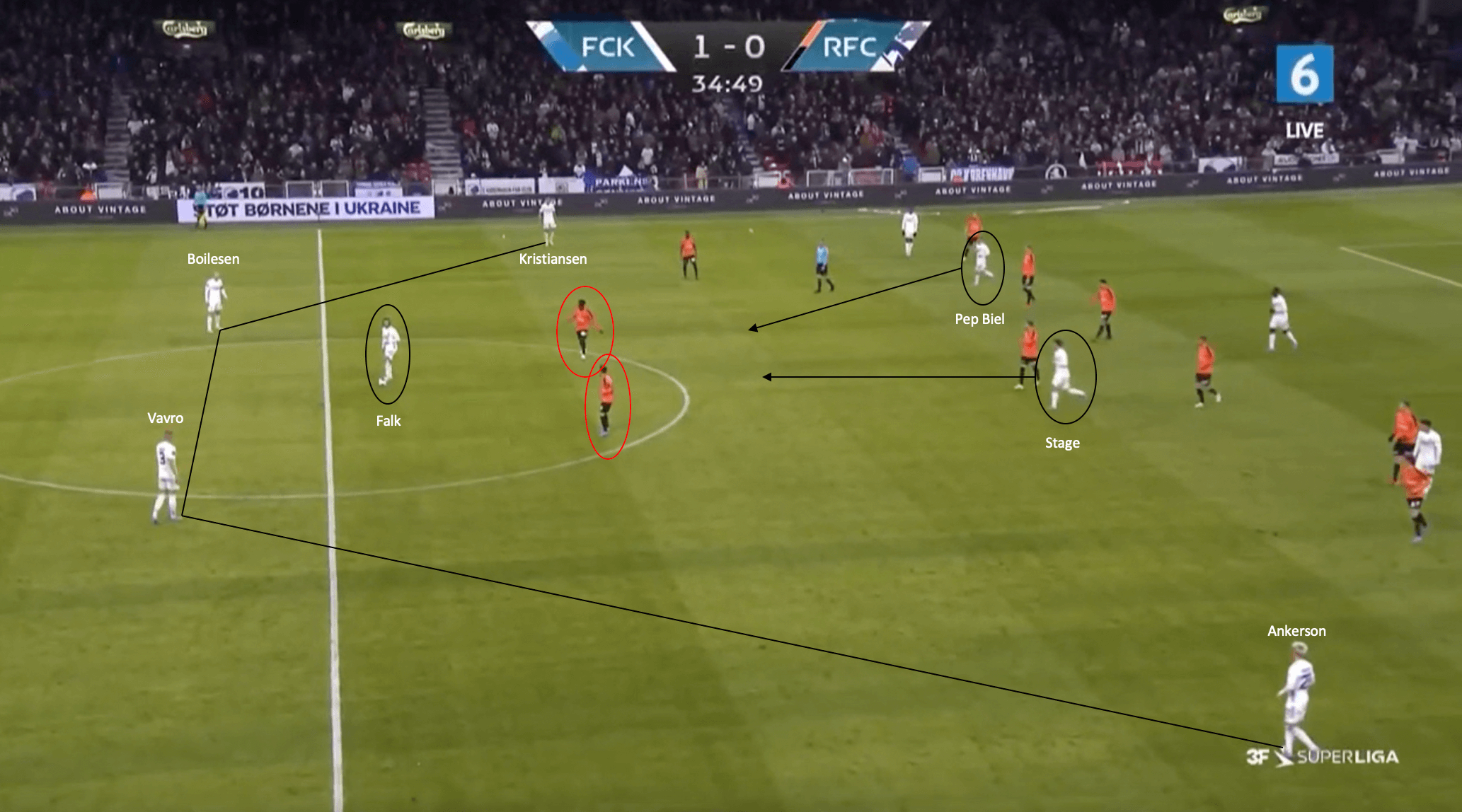
This final example shows how the central spaces are also able to be exploited as a result of Thorup’s style of build-up. In this phase of play against Randers, the two most advanced Randers players are attracted to the pass being received by Falk. This allows both Stage and Pep Biel to drop into the pockets of space centrally. Stage receives the pass, who plays it out wide to an advancing Kristiansen. Though the play is eventually sent out wide, København had to improvise with the Randers’ defenders making sure not to get dragged inside to allow the space out wide. This demonstrates that when it comes to build-up play, Thorup is able to respond to any tactical changes that opposition managers might make throughout a match.
Using overloads in the final third
When it comes to chance creation in the Danish Superliga this season, FC København are the best. Along with being the highest goal scorers in the league with 44 goals scored, they have also created 98 chances, another league high. Wide play is important in the attacking structure of this FC København side under Jess Throup, especially using overloads to try and dominate the wide areas in the final third.
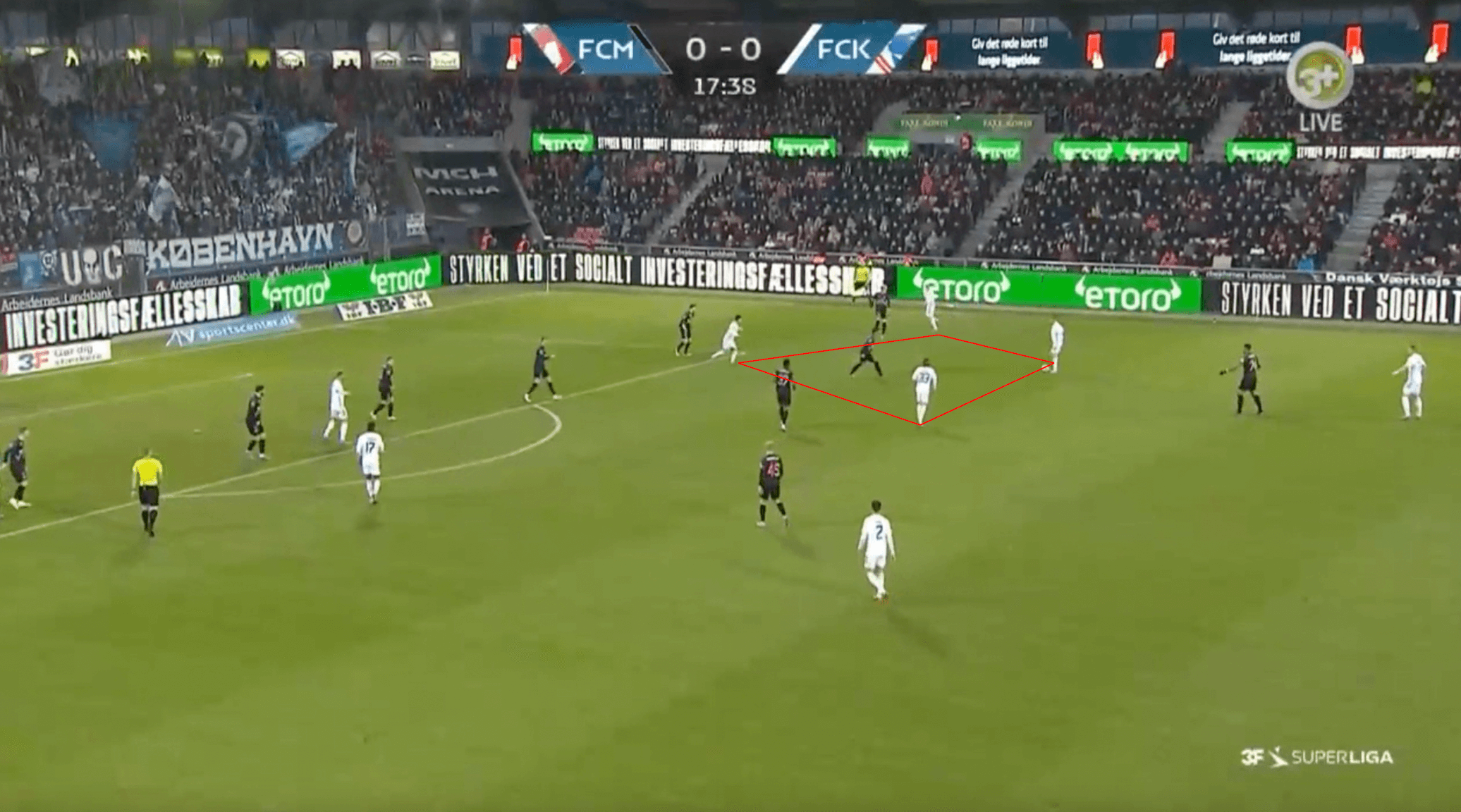
The image above from København’s match against Midtjylland shows a great example of these overloads that Throup likes to utilise. København have Midtjylland outnumbered 4v3 in the wide area, which allows them to utililse quick passing as well as off the ball movements to create a goal-scoring chance. In this specific phase, Pep Biel is able to play a pass to Falk, which then frees up both Biel and Roony to make off the ball movements to free up Ankerson running in behind the defence down the touchline. A through ball is eventually played in behind to find Ankerson, who subsequently wins a corner for København.
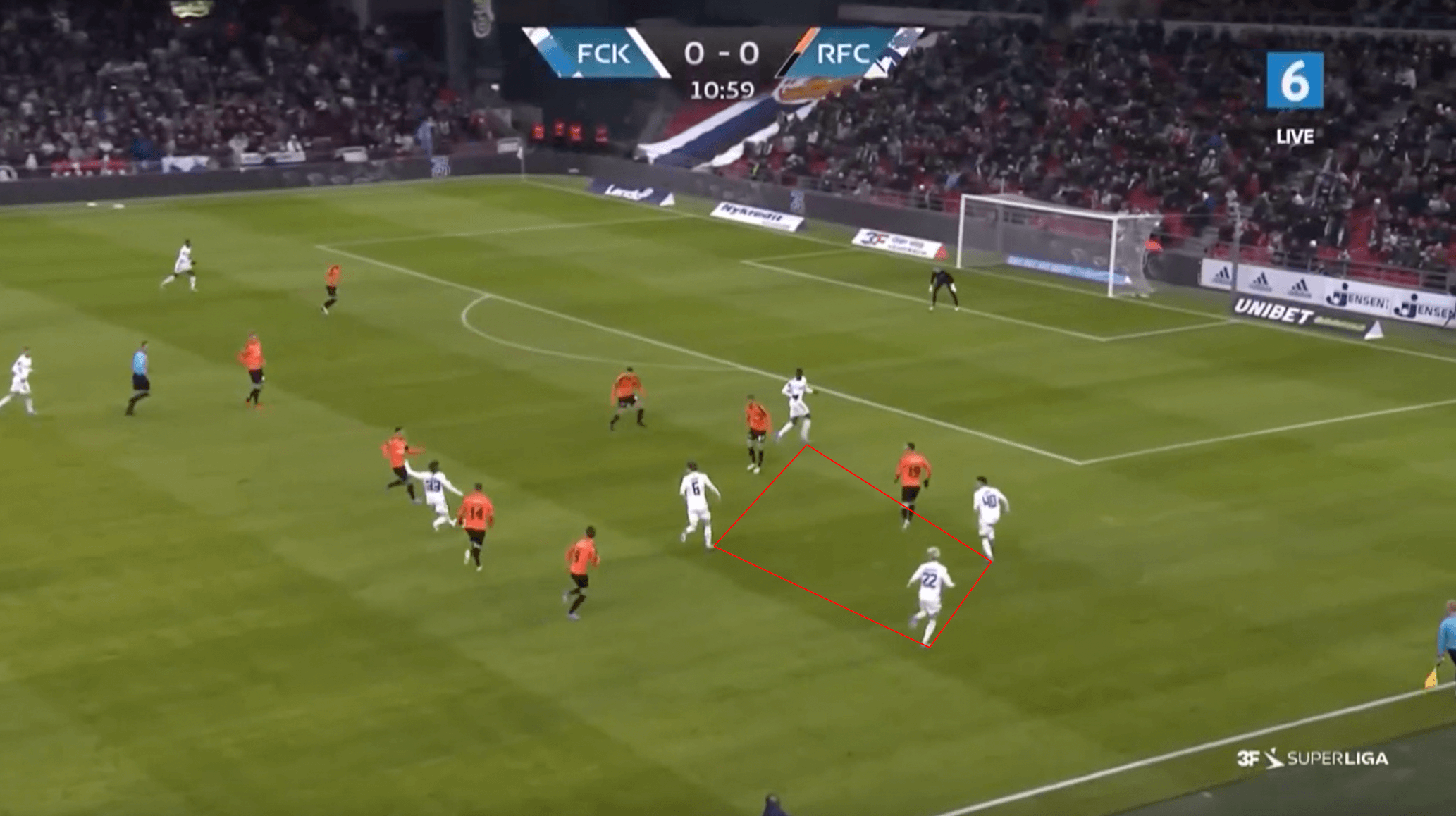
The image above from København’s match against Randers is able to demonstrate another example of the overloads that Jess Throup has looked for his side to utilise in wide areas. In the wide right half-space, København players are outnumbering the Randers players 4v2, which forces the defenders to be dragged into this area so they are not at a numerical disadvantage. As a result, this is able to open up space for Pep Biel to run into centrally, as well as create a 1v1 for Paul Mukairu on the far side. Falk looks to switch the play to Mukairu, but unfortunately, his pass is blocked by a Randers defender, with the keeper able to eventually claim. Though the overload was not directly utilised in this attacking phase of play; it indirectly was able to create the space for both Pep Biel and Paul Muakiru, who were able to find themselves in 1v1 situations both centrally and on the far side of the pitch.
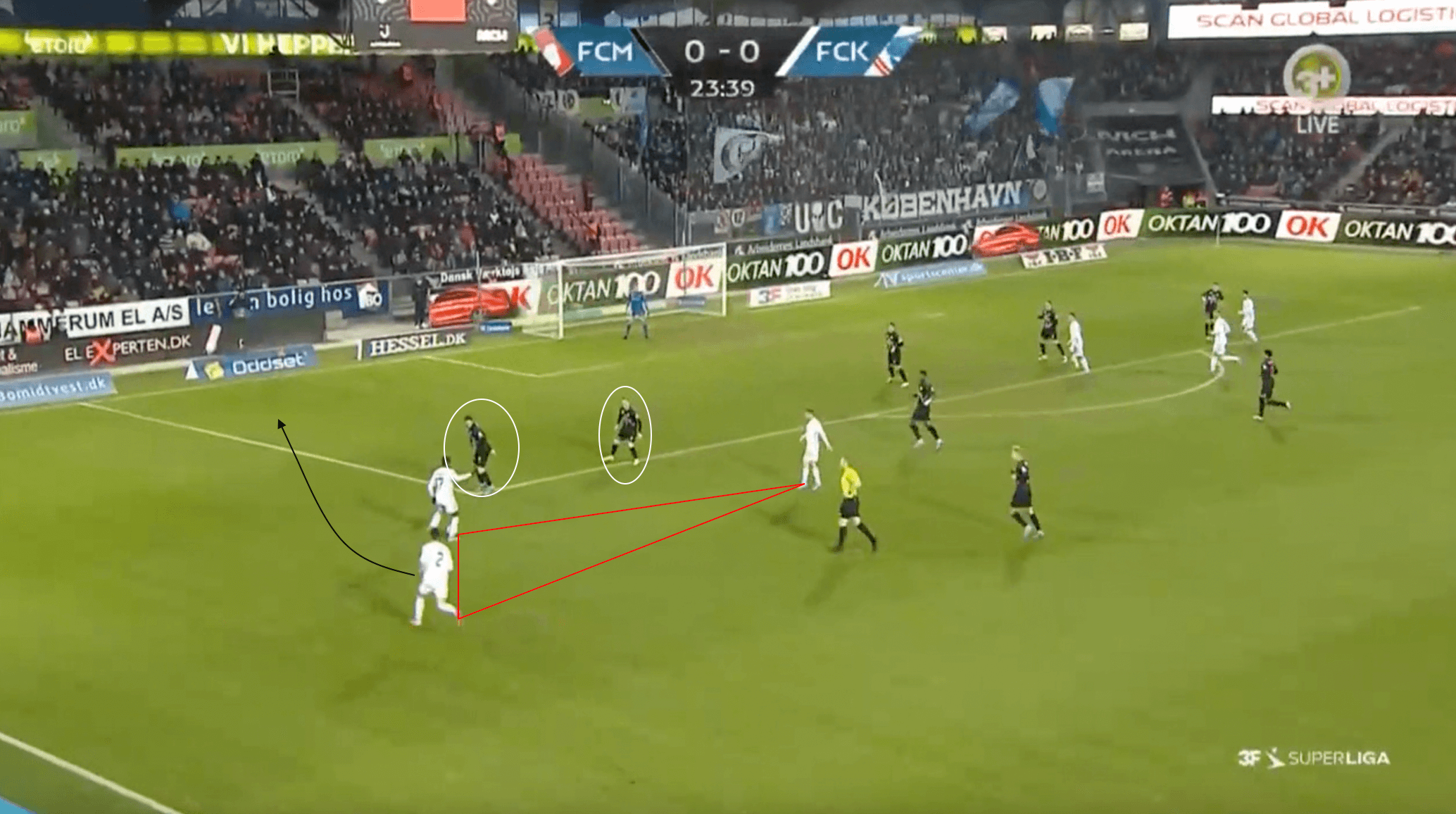
Above shows another example of the utilisation of overloads to create numerical advantages for København in the wide areas. Pep Biel moves into a wider position to create an attacking triangle, as well as outnumber Midtjylland 3v2 in this area. This movement by Biel to create the overload allows Diks to make an overlapping run unmarked past Mukairu. This movement also attracts the two Midtjylland midfielders closest to Biel, who move into the wide space to regain superiority numerically. Unfortunately, København are not able to create a goal-scoring chance as a result of this overload, with the play eventually being recycled to try and create a new attacking sequence. Though no chance was created directly from this overload, it shows the tactics that Jess Thorup has implemented to help København become the best attacking side in Denmark.
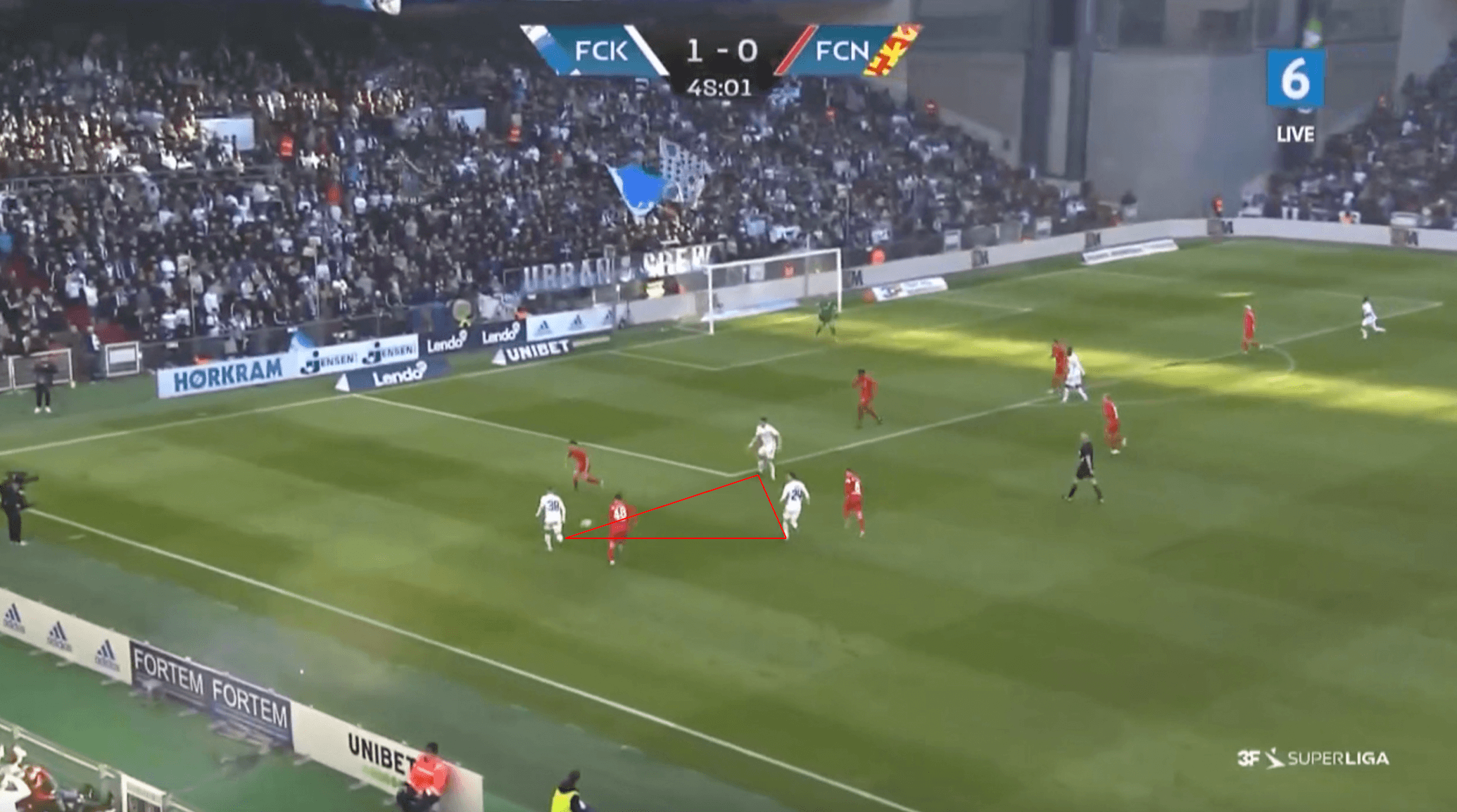
The final example for this section shows another overload that forces the attention of the opposition midfielder. Because of the 3v2 numerical advantage in København’s favour, it forces the Nordsjælland midfielder to move wide as well. As mentioned, these wide overloads are key for this København side when the ball reaches the final third, and the utilisation of them is one reason that the capital club are the highest scorers in the Superliga.
Compact defensive structure
When it comes to the defensive side of the game, FC København are also the best side in the league. Jess Thorup’s side have only conceded 13 league goals this campaign, nine less than both Midtjylland and Silkeborg. This section will take a look at some examples of the defensive solidity that this København side display.
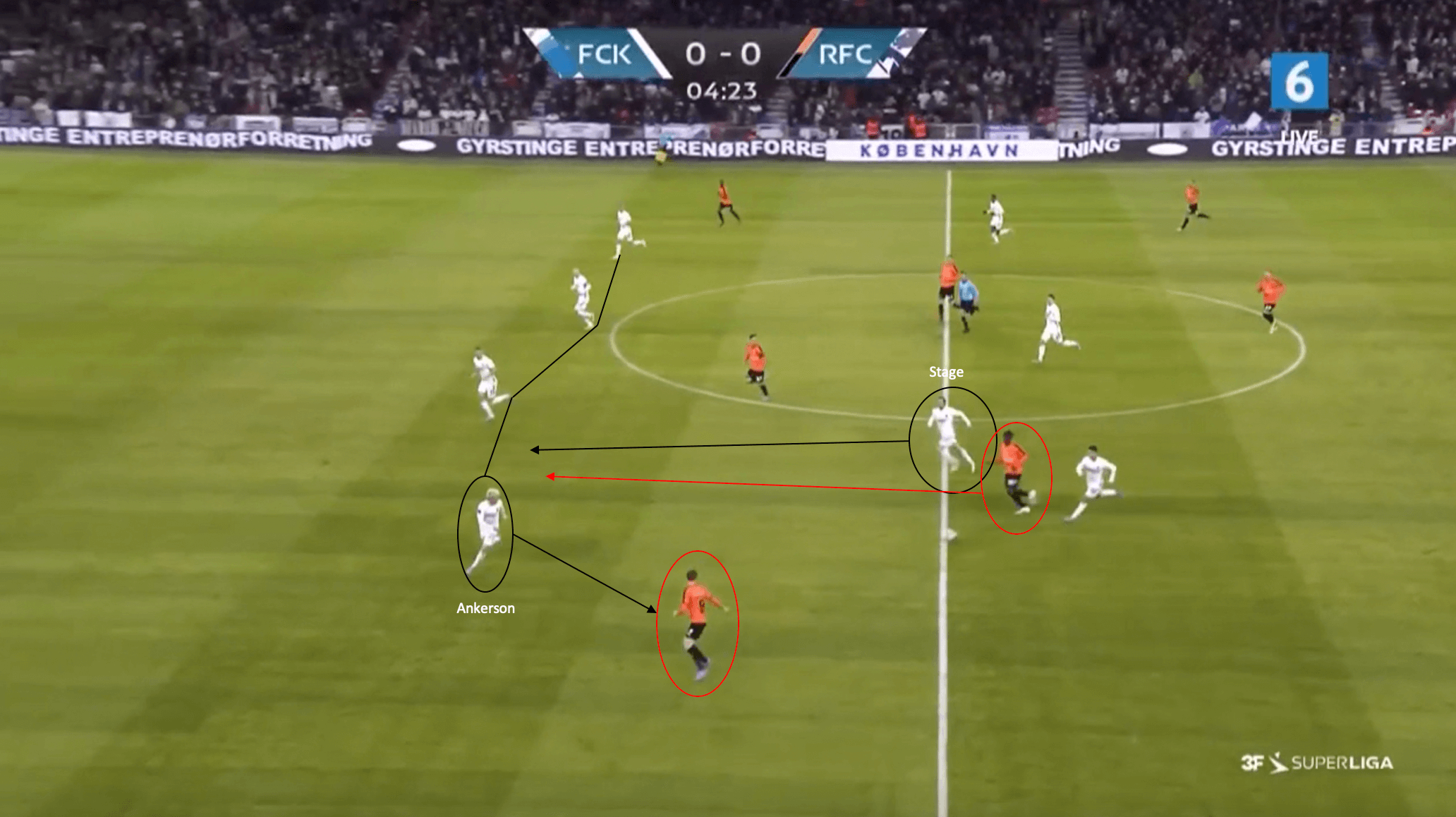
The image above shows an example of why København are such a compact side when in defensive phases. The previous attacking phase resulted in a turnover in midfield, which allowed Randers to start a quick counterattack. The back four of København are able to quickly get back into their defensive shape, stopping any chance Randers had of a quick break. Subsequently, Ankerson recognises that the pass is going to be played out to the winger on the near touchline, so he steps out of the backline to engage him. Stage recognises this and fills the vacant left-back position left by Ankerson. It also allows him to mark the run of the opposing player, which prevents the one-two passing option into the vacant space behind the back four. As a result, Randers are forced to try and switch the play over to the far side to try and keep the attacking momentum going; but the pass is overhit, and København are able to retain possession.
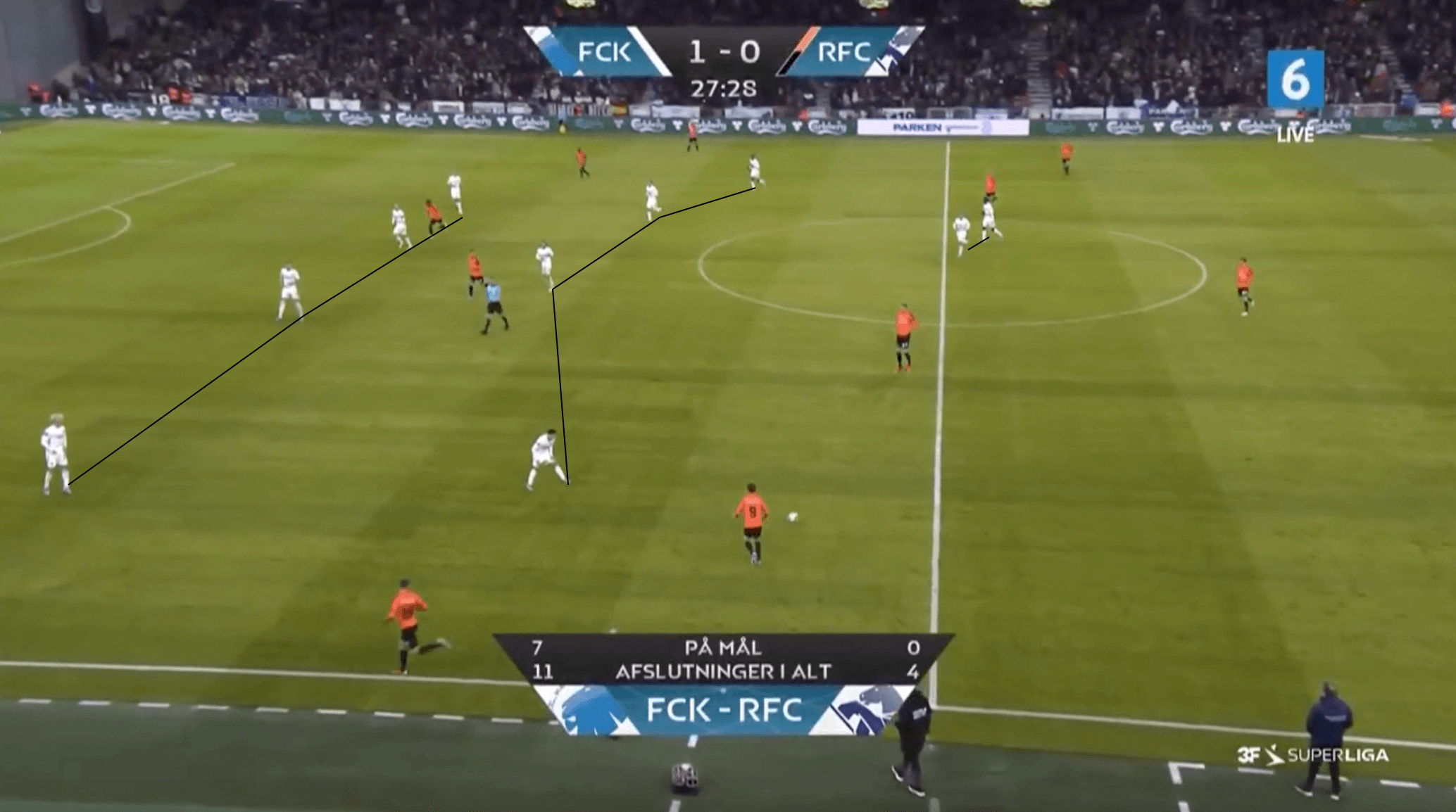
The image above shows the typical defensive shape that FC København shift to when the opposition are in possession. The shape becomes a 4-4-2, with the defensive and midfield lines staying tight and compact so as to not allow the opposition to have space to play between the lines. This means that the opposition typically have two options of getting through this defensive shape; either by playing long balls over the top to runners, or trying to recycle play to find an opening. The København defenders excel in aerial duels, which makes playing over the top rather challenging for opposition sides, as the ball is normally just headed away from danger. Trying to recycle play is also tough for opposition sides, as Pep Biel’s pressing ability puts pressure on the opposition, normally forcing turnovers in midfield as a result. This structure is what makes København so difficult to break down for opposition sides.
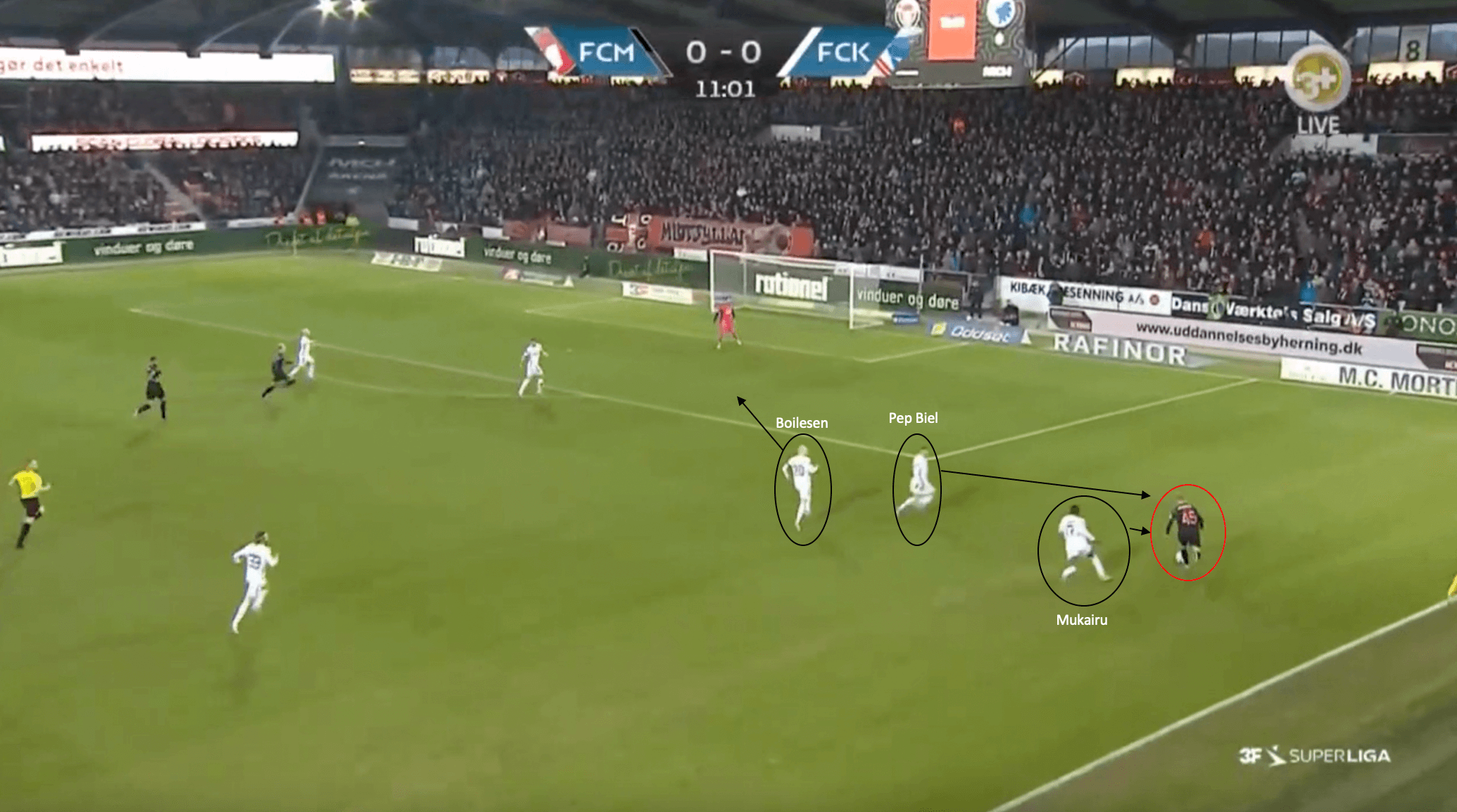
When it comes to defending in transition, as the first example showed, København are probably the best side in Denmark. Above is another example of the work rate shown by the capital-based club when defending in transition. Preceding the defensive phase shown above, København had a throw-in inside the opposition half. The subsequent throw was misjudged by Boilesen, and as a result, allowed Midtjylland to gain possession and drive towards the penalty box. With Diks (left-back) out of position in the attacking third, both Pep Biel and Mukairu drop back to cover the vacant left-back position. This then allows Boilesen the freedom to drop back into his centre-back position, eliminating the option of a Midtjylland player making an unmarked run into that space. As a result, Biel is able to win back possession for København; stopping what would have been a very good goal scoring opportunity for Midtjylland.
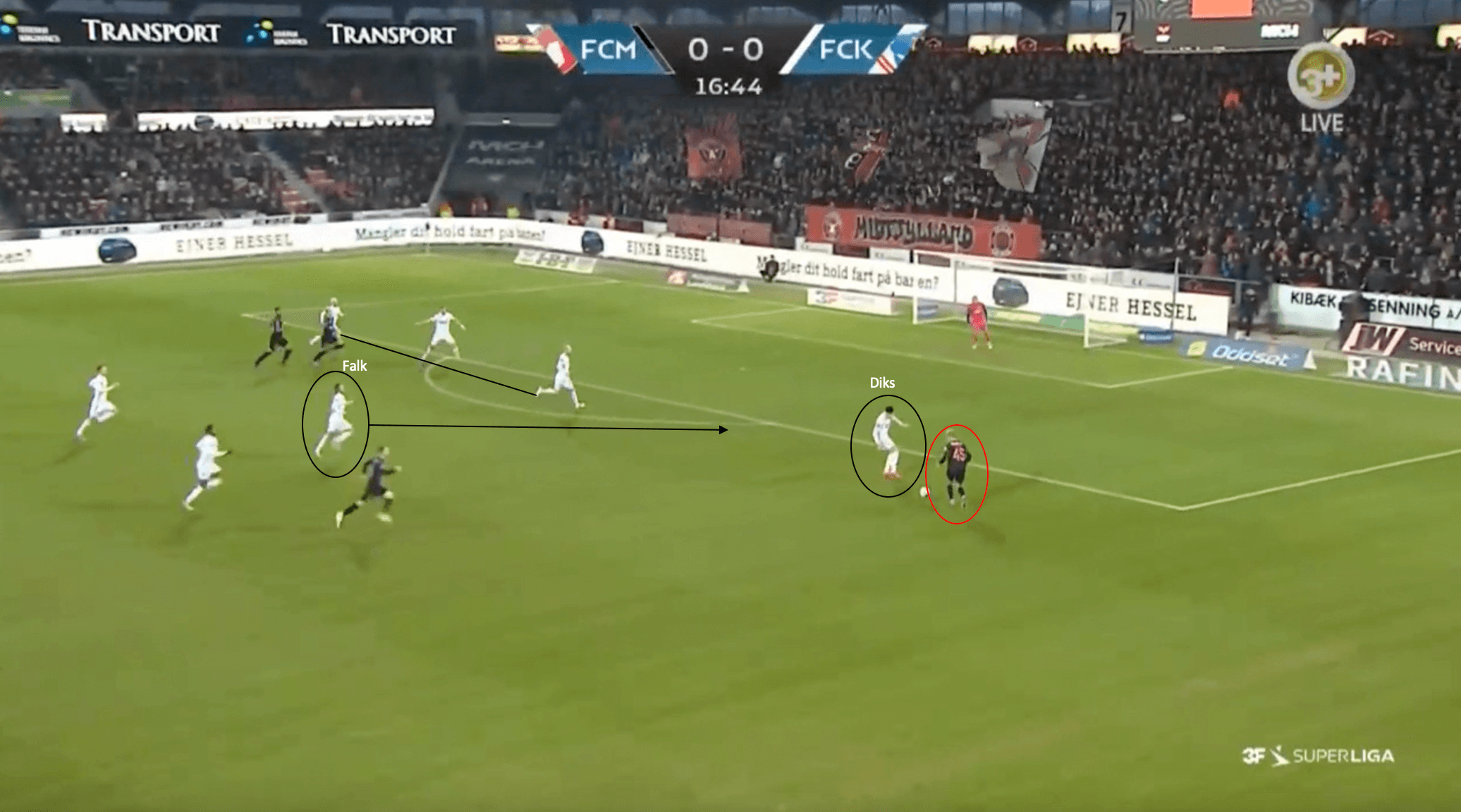
This final example once again demonstrates the ability of this København side to cover for each other defensively. In this defensive phase of play, Diks moves out of the back four to look to engage the Midtjylland player in possession on the edge of the 18-yard box. As a result, Rasmus Falk is quick to get back and move into that vacant left-back position, which forces the Midtjylland player to make an overlapping run instead of an underlapping run. This subsequent delay by the Midtjylland runner allows the time for Falk to help Diks engage the player in possession, winning back possession as a result and clearing the danger.
This final section has demonstrated the defensive structure of this FC København side, and the strides that they have made since Jess Throup was appointed around 18 months ago.
Conclusion
In his first full season in charge at FC København, Jess Thorup looks on course to guide the Copenhagen based club to their first league title since the 2018/19 campaign. This analysis piece has looked over the tactics implemented by Thorup to make his side the best both going forward and defensively. Thorup has also been able to do this in the face of heavy squad turnover, with key players Mohamed Daramy and Jonas Wind both being sold (to Ajax and Wolfsburg respectively); and also a new starting goalkeeper being brought in, with Kamil Grabara being brought in from Liverpool’s reserve side. All that being said, Jess Throup has brought the title-winning mentality back to FC København, with the future looking bright under the Dane.





Comments